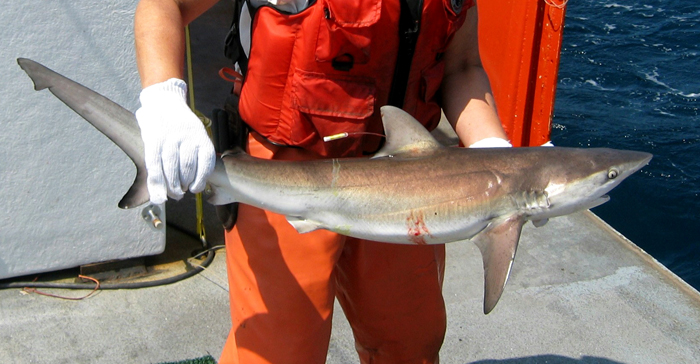Vulnerable Dusky Sharks Decimated by Fishing (Op-Ed)


Amanda Keledjian is a marine scientist at Oceana, the largest international conservation organization working solely to protect the world's oceans. She contributed this article to Live Science's Expert Voices: Op-Ed & Insights.
With upwards of 100 million sharks killed around the world every year, it's no surprise that their numbers have plummeted. In fact, a quarter of the world's shark and ray species are threatened with extinction, according to the International Union for Conservation of Nature's (IUCN) Red List of Threatened Species.
One species of concern is the dusky shark, a wide-ranging species commonly found along continental coastlines in tropical and temperate waters. Dusky sharks can grow to be 14 feet (4 meters) long, and mainly feed on bony fish, squid, and other sharks and rays. Several characteristics make this species of shark particularly vulnerable to over-exploitation, including the fact that dusky sharks do not give birth to many pups each year. The dusky shark also takes 20 years to reach maturity, making it one of the slowest growing of known sharks.
Scientists estimate that the dusky shark population off the coast of the Southeastern United States and Gulf of Mexico has plummeted between 70 and 98 percent during the last 40 years.
Like most sharks, dusky sharks are highly valued for their fins, which are commonly used in the Asian delicacy shark fin soup. The demand for this cuisine has outpaced these sharks' ability to restock their numbers, putting them in steep decline globally. Illegal and unregulated fisheries also often target these animals outside of U.S. waters. [Sharks Gain Protections in India, Will U.S. Follow Suit? (Op-Ed)]
For more than a decade, regulations have prohibited commercial fishermen in the United States from targeting or landing dusky sharks. However, that does not mean they aren't still caught. One of the main threats facing dusky sharks is bycatch, which is the catch of non-target fish and marine wildlife , often due to indiscriminate and harmful fishing gear.
In fact, in 2010 more than 3,400 dusky sharks were captured and discarded as bycatch in just two bottom longline fisheries in the southeast region of the United States — even though it is illegal to deliberately catch these animals. These fisheries use lines that can be many miles long and are studded with thousands of baited hooks. With a population that is already listed as vulnerable, this overfishing could push the dusky sharks' numbers into further peril.
Get the world’s most fascinating discoveries delivered straight to your inbox.
In a new report released last month, Oceana identified nine of the worst fisheries in the United States for bycatch — one of which, the Southeast Snapper-Grouper Longline Fishery, catches and then discards more than 400,000 sharks annually. Unfortunately, these sharks don't often survive afterward.
However, there are ways to reduce the number of dusky sharks caught as bycatch. Fisheries in the United States should adopt a three-pronged approach to reduce bycatch: count, cap, and control. Fisheries should count all catch (including bycatch), cap bycatch using science-based limits, and control bycatch through effective management measures that will ensure bycatch limits are not exceeded and that bycatch is reduced over time.
Lastly, fisheries need to control bycatch by using gear that is less destructive to the environment and by implementing initiatives that effectively work to avoid bycatch. These policies include catch-monitoring programs that identify and release information about bycatch hotspots to all fishermen across a fleet, so they can actively avoid fishing in those areas.
There's no reason dusky sharks should remain overfished when regulations have prohibited their capture for a decade. With the sharks' numbers dwindling, the National Marine Fisheries Service must implement science-based management approaches to minimize bycatch.
Oceana's most recent Op-Ed contribution was "Tar Washing Ashore Shows Gulf Coast NotBack to Normal." Follow all of the Expert Voices issues and debates — and become part of the discussion — on Facebook, Twitter and Google+. The views expressed are those of the author and do not necessarily reflect the views of the publisher. This version of the article was originally published on Live Science.



